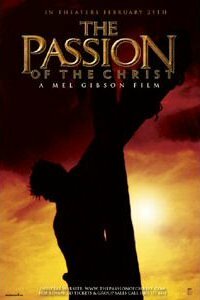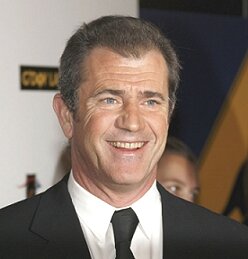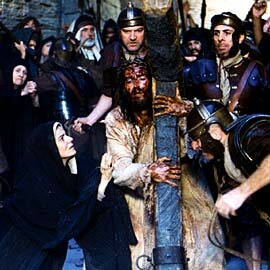 What made The Passion of the Christ a hit?:
What made The Passion of the Christ a hit?: In the 1950s, the popularity of the “religious pictures” genre was at its peak, with Hollywood studios making big-budget Biblical adaptations featuring lush production values and big stars. However, half a century later the genre had long since degenerated into cut-rate affairs starring Tinseltown has-beens and never-would-bes. So when Mel Gibson, at the time not only one of Hollywood’s biggest stars but also an Oscar-winning filmmaker, decided to leverage his considerable clout to make a movie about Christ’s crucifixion- and in two dead languages, no less- most showbiz insiders declared the project to be an epic folly.
What they didn’t count on was Gibson’s ability to mobilize the Christian audience, a demographic too infrequently catered to by the studios. Gibson screened the film for months in advance for religious leaders of all stripes, from Protestant ministers to His Holiness, Pope John Paul II. This in turn led to an unprecedented number of special church-group screenings, reeling in many viewers who didn’t often attend movies, much less non-English-language films. By the time of the film’s release, a great deal of hype (and no small amount of controversy) has sprung up around
The Passion, reeling in not only religious but secular viewers as well.
The Passion quickly became an unlikely success, bringing in nearly $371 million in the United States alone, the highest gross of any R-rated film to date, as well as becoming the highest-grossing film ever made in a foreign language, dead or otherwise.
What happened?: Like it or not, people usually go to movies to enjoy themselves, and
The Passion of the Christ wasn’t a whole lot of fun. With its religious subject matter and extreme violence, The Passion was the sort of movie most of its viewers watched more out of a perceived religious obligation than a desire to be entertained, and the repeat business was minimal. The following spring brought Gibson’s somewhat toned down edit entitled
The Passion Recut, but this new version was a box office disaster. In addition, the crush of religious-themed mainstream movies that
The Passion’s success seemingly heralded never happened, revealing the movie’s blockbuster grosses to be more a singularity than a sign of a new direction in audience tastes.
Does The Passion of the Christ still work?: Yes, and much better than it did on my first viewing, truth be told. As an agnostic, I initially found Gibson’s approach

alienating, because so much of the film’s impact is dependent on a viewer’s acceptance of Christ’s divinity. But having seen the film a second time removed from the hype, I found myself more in agreement with Gibson’s methods. No,
The Passion doesn’t really court the non-believers in the audience, but that’s not its goal, and it would be a mistake to hold that against it.
This isn’t to say the film doesn’t have its faults. Gibson is a talented filmmaker, but he’s often prone to overstatement, and his lack of subtlety distracts from some of the more powerful aspects of the film. This is most apparent in his portrayal of the Pharisees, shown here as a group of bloated, pompous elders puffed up by their own self-importance. Rather than showing how threatened they were by the power Jesus had over His disciples, Gibson instead turns them into one-dimensional villains. In addition, there are several other scenes- Judas Iscariot being hounded by demonic children, Jesus as a carpenter seemingly inventing the tall table- that just plain don’t work.
But overall, the film is better than I’d remembered. Jim Caviezel’s work as Christ is pretty heroic considering how much of his screen time is spent being beaten, tortured, and crucified, but he also makes a surprisingly down-to-earth Christ in his calmer scenes in flashback. Likewise, there are a number of effective supporting characters to serve as audience surrogates. Unlike the Pharisees, Pontius Pilate (Hristo Shopov) is seen with complexity as a victim of circumstance, a man who’s torn between keeping the peace and freeing a prisoner who committed no wrongdoing. I also liked the way Gibson uses the character of Simon of Cyrene (Jarreth Merz), who the Romans rope into helping Jesus carry the cross only to find himself horrified at the brutality with which he’s treated.
Most poignant of all is Maia Morgenstern as Mary, Jesus’ mother. Rather than sanctifying the character, Gibson and Morgenstern turn Mary into a terrified woman witnessing her son’s violent, protracted death. Of all His followers, only she can truly be sure of His divinity, but that matters little in light of the violence that is committed against Him. She’s a believer to the end, but she’s also the same woman who has cared for him all His life. Morgenstern’s performance is largely wordless, but the look in her eyes says everything we need to know.
Ultimately, the movie succeeds as an illustration of the trials Jesus Christ faced in the final days before His death. This comes through most clearly through the graphic

nature of its brutality, with Gibson lingering on every blow from the torturers’ weapons, every thorn that pierced His head from the Roman soldiers’ scornful makeshift crown, every stumble under the weight of the cross. And the movie doesn’t shy away from the violence once He’s reached Calvary either- we see the nails pierce His flesh and the mounting of the cross itself (with Christ attached, no less). Never before has a film made so plain how much suffering that Christ endured, it is said, for our sins.
But there’s more to the film than blood and gore. What makes these scenes as effective as they are is that Gibson focuses on Christ’s humanity rather than his divinity. “Behold the man,” says Pilate to the crowd gathered for Jesus’ trial. For nearly the entire film, God is absent from the proceedings, although Satan makes several appearances to tempt Jesus to turn his back on God. This makes the experience feel that much lonelier for Christ, who has given His life for His Father only to have to forge on alone when He needs Him most (little wonder that He cries out, “why have you forsaken me?”). This in turn makes His sacrifice that much more meaningful, that He would not only give in to His punishment, but would willingly subject Himself to it in the first place, out of belief that it would indeed make a difference. After viewing
The Passion, Pope John Paul II was rumored to have stated, “it is what it is.” Yes, and in that respect, it works.